Mitali Perkins's Blog, page 36
January 10, 2011
ALA Midwinter in San Diego: Sunshine and Signings
Spent the morning by the fire in Boston watching the ALA Youth Media Awards announcements (Newbery, etc), but still relishing the sunny respite in San Diego, courtesy of Charlesbridge, who published Bamboo People. I took two long walks along the water:

It was 18 degrees in Boston when I took this in San Diego.

They were enjoying the sunset as much as I was.

San Diego's marina in the evening ...

... and in the morning.

So Cal Caloric Splurge: Swordfish Taco and Waffle Fries
... Presented a speech during USBBY's annual meeting, after the Outstanding International Books of 2011 were announced:
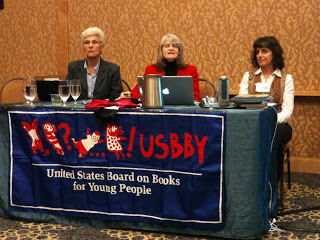
The 2011 list is revealed ...
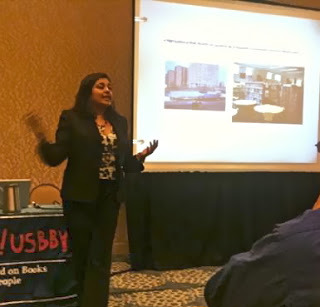
Photo courtesy of Cindy Pon (SILVER PHOENIX).
... And signed copies of Bamboo People as well as the foreword to Harper Perennial's re-issue of Emily of Deep Valley , along with Melissa Wiley, who was equally flabbergasted to be signing the foreword to Carney's House Party / Winona's Pony Cart.
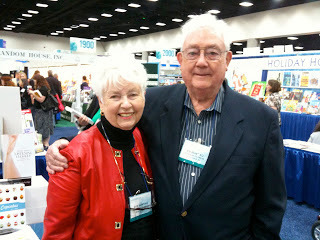
Ed and Eve Bunting stopped by the Charlesbridge booth. They've been married for 60 years and he still carries her books.
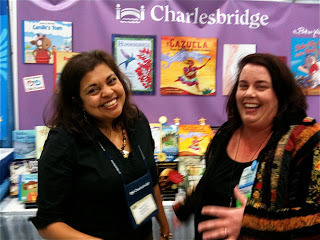 Librarian Beth Friese and I shared a fangirl moment after the Buntings departed. For goodness' sake — I had to personalize a copy of Bamboo People to EVE BUNTING!
Librarian Beth Friese and I shared a fangirl moment after the Buntings departed. For goodness' sake — I had to personalize a copy of Bamboo People to EVE BUNTING!
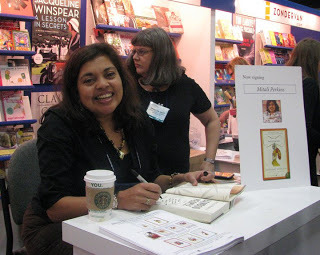
Photo courtesy of Sarah Stevenson, who was there signing copies of her excellent debut YA novel, The Latte Rebellion (Flux).
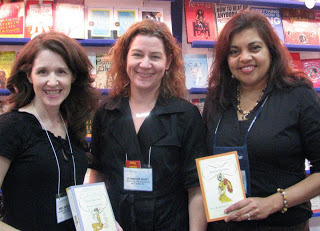
The triumvirate--Tib (Melissa Wiley), Betsy (HarperPerennial editor Jennifer Hart), and Tacy (me)--after our signing.
Come visit me on the Fire Escape!





It was 18 degrees in Boston when I took this in San Diego.

They were enjoying the sunset as much as I was.

San Diego's marina in the evening ...

... and in the morning.

So Cal Caloric Splurge: Swordfish Taco and Waffle Fries
... Presented a speech during USBBY's annual meeting, after the Outstanding International Books of 2011 were announced:

The 2011 list is revealed ...

Photo courtesy of Cindy Pon (SILVER PHOENIX).
... And signed copies of Bamboo People as well as the foreword to Harper Perennial's re-issue of Emily of Deep Valley , along with Melissa Wiley, who was equally flabbergasted to be signing the foreword to Carney's House Party / Winona's Pony Cart.

Ed and Eve Bunting stopped by the Charlesbridge booth. They've been married for 60 years and he still carries her books.
 Librarian Beth Friese and I shared a fangirl moment after the Buntings departed. For goodness' sake — I had to personalize a copy of Bamboo People to EVE BUNTING!
Librarian Beth Friese and I shared a fangirl moment after the Buntings departed. For goodness' sake — I had to personalize a copy of Bamboo People to EVE BUNTING!
Photo courtesy of Sarah Stevenson, who was there signing copies of her excellent debut YA novel, The Latte Rebellion (Flux).

The triumvirate--Tib (Melissa Wiley), Betsy (HarperPerennial editor Jennifer Hart), and Tacy (me)--after our signing.
Come visit me on the Fire Escape!




Published on January 10, 2011 11:57
January 6, 2011
ALA Midwinter in San Diego
"San Diego." "Midwinter." Don't you love the juxtaposition? This weekend, I'm fortunate to be attending the American Library Association's Annual Midwinter Conference in San Diego, California.
I'm speaking at USBBY's Membership Meeting during the ALA Library Conference on Friday, 1/7, 8-10 p.m. at the Hilton in Indigo 202A/B. The Outstanding International Children's Books Committee will present their 2011 selections, followed by my talk. Anyone with an interest in children's and/or young adult literature is welcome to attend.
On Saturday, I'll be in Charlesbridge's booth from 10-11 (#1808) signing BAMBOO PEOPLE. Then I head over to Harper Collins' booth (#2016) from 11:30-12:30, reverentially signing Maud Hart Lovelace reissues with author and fellow foreword writer Melissa Wiley -- I'll be signing EMILY OF DEEP VALLEY while she personalizes CARNEY'S HOUSE PARTY.
Last but not least, I'm excited that Bamboo People is nominated as an ALA Notable Children's Book and is a candidate for YALSA's Best Fiction for Young Adults. We shall see if it makes the final lists, but it's an honor to be considered.
Will I see you in San Diego? I hope so.Come visit me on the Fire Escape!




I'm speaking at USBBY's Membership Meeting during the ALA Library Conference on Friday, 1/7, 8-10 p.m. at the Hilton in Indigo 202A/B. The Outstanding International Children's Books Committee will present their 2011 selections, followed by my talk. Anyone with an interest in children's and/or young adult literature is welcome to attend.
On Saturday, I'll be in Charlesbridge's booth from 10-11 (#1808) signing BAMBOO PEOPLE. Then I head over to Harper Collins' booth (#2016) from 11:30-12:30, reverentially signing Maud Hart Lovelace reissues with author and fellow foreword writer Melissa Wiley -- I'll be signing EMILY OF DEEP VALLEY while she personalizes CARNEY'S HOUSE PARTY.
Last but not least, I'm excited that Bamboo People is nominated as an ALA Notable Children's Book and is a candidate for YALSA's Best Fiction for Young Adults. We shall see if it makes the final lists, but it's an honor to be considered.
Will I see you in San Diego? I hope so.Come visit me on the Fire Escape!




Published on January 06, 2011 06:10
November 15, 2010
Winter Leads Me To A Virtual Stillness
Brrr ... it's getting chilly out here on the Fire Escape. I'm going in where it's warm. Starting my annual winter hiatus to write, reflect, dream, and pray. Might pop back if something grabs me, and will be somewhat accessible through social media. Stay warm, friends!Come visit me on the Fire Escape!








Published on November 15, 2010 05:49
November 11, 2010
Is EMILY OF DEEP VALLEY a Timeless Classic?
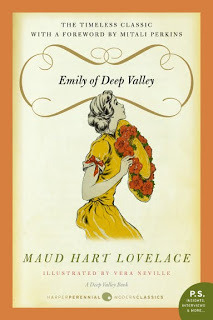 Thanks to everybody who participated in our
Cuci Mata
("fresh eyes" in Indonesian) read of Emily of Deep Valley by Maud Hart Lovelace. I'll let a group of stellar bloggers make their case.
Thanks to everybody who participated in our
Cuci Mata
("fresh eyes" in Indonesian) read of Emily of Deep Valley by Maud Hart Lovelace. I'll let a group of stellar bloggers make their case.Booking Mama thinks it deserves the label : "Emily of Deep Valley delves into some topics that were pretty much taboo when she wrote this book, namely depression and racism."
She Is Too Fond Of Books agrees : "I found in (EMILY) a soul sister of sorts, with her unconventional methods of finding her place in the world ... Although I'm hoping you'll read all the Betsy-Tacy books, this novel can be read on its own and might make a good introduction if you don't have time to commit to the entire series (make time!)."
Diary of an Eccentric definitely thinks it's a classic: "The more I get to know Lovelace's characters, the more I realize that her books are timeless. It was easy for me to identify with Emily, from her bouts of depression to feeling out of place as friends grow apart — and of course, most of us remember having crushes on guys who didn't deserve our attention."
A Library is a Hospital for the Mind continues the case: "What surprised me was how applicable this story is to readers today. I had no idea when I picked up Emily of Deep Valley that I would be pondering immigration laws, racial and social discrimination, and the like. Who knew that a book written nearly sixty years ago could address and connect the same concerns Americans have today as they had one hundred years ago."
And what does Charlotte's Library think about the representation of race and culture in the book?
Ethnicity-wise....it was very, very interesting to see Emily and her allies take on the narrow-minded bigots in town who looked on the Syrian immigrants with dislike and distrust. Emily's dream of a tolerant America is a lot less cynical then mine, but that might be my loss...and her final argument for why the Syrians should be embraced, and made welcomed, is one that I could cheer for—Emily wants their differences celebrated, as something that can contribute positively to the whole of American culture. Yay Emily!I love this post from Four Cedar Farms, written before the re-issue, but nonetheless ringing with the argument that yes, this book stands the test of time:
There was just one thing that has been vexing me. Early in the book, her aunt's house is described thus: "There was a fern in a brass bowl on the newel post, and an Indian head on the wall. Emily loved these bright modern touches." (page 8 of my edition). I have googled interior design of 1912 to death today, and not found anything that casts light on just what sort of Indian head is meant....and indeed, Lovelace, when she mentions Native Americans, which is seldom and in passing, shows no signs of awareness of the injustices and wrongs perpetrated by Emily's colonizing ancestors...
So that's the one thing I'd change. Otherwise, I think this is pretty much a perfect book!
I have ancestors who were known around another river town as "the Syrians." And like the Syrians in Hart Lovelace's book, my family was marginalized, called names by the "better" citizens of their town. Their immigration was not welcomed by those who felt the United States had enough people. They struggled with language and social structures and yet lived full lives in "shabby houses that needed paint." I like to think that someone like Emily might have wandered into my ancestors' neighborhood, into my ancestors' lives, to extend to them some version of Emily's small-town spirit of friendship. And why not? Hart Lovelace's fiction is based on her early life experiences. Her stories are authentic. Her stories are timeless.I'll let Book Duck have the last word : "Emily is a girl with a spine. The most important thing (she) does with her time, though, is reach out to the community of Syrian immigrants just outside Deep Valley. The townspeople and children give the immigrant community a hard time because of their odd manners and broken English. Immigrants still come to America, and people still forget that poor English is not a synonym for 'stupid.' While idealistic, Emily of Deep Valley challenges readers to rethink their gut reactions to people who are different in manner and custom."
It is 2010 and the immigrants living on the fringe of our communities in shabby abodes hail from a different part of the world than Ottoman-controlled Syria. Yet, I'll bet they hear people whisper derogatory names when they pass. I'll bet some people feel they don't belong here; the country is full enough. Still, I'd bet my carriage that despite the majority's indifference to them, they are living out rich traditions and full lives in the shadow of the American dream like my ancestors once did. And I'll bet somewhere in America there's a teenager who, because of the example set by the fictional Emily Webster, is confident enough to step forward make a difference in their lives.
As for me? For this, our first Cuci Mata read, I'm going to ask you to read the preface I so gladly wrote for the re-issue. A star debater who uses her elocutionary skills to defend the rights of the powerless? That's a hero who stands the test of time. I hope you're convinced that this book deserves the "classic" label. Go get your copy of Emily and share it with the girls in your lives.
If you're in the Boston area, come join us for afternoon tea this Saturday, November 13, at the Brookline Booksmith , where we'll talk all things Lovelace and I'll try to make a case for Emily as a classic in person.
Note: If I've missed your review, please add it in the comments. The first week of December is dedicated to a Cuci Mata read of L.M. Alcott's Old-Fashioned Girl. Come join us to see if this novel stands the test of time.Come visit me on the Fire Escape!




Published on November 11, 2010 09:46
November 8, 2010
Chatting in 140 with Roger Sutton about A FAMILY OF READERS
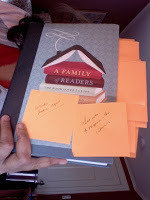 I devoured and post-it-ed my copy of
A FAMILY OF READERS
before today's noon chat with co-author Roger Sutton, editor of The Horn Book. Here are a few highlights of our slightly frenetic talk via Twitter. Please remember and excuse the limitation of 140 characters per tweet. I'm in italics, Roger is not, and I've edited for brevity and flow.
I devoured and post-it-ed my copy of
A FAMILY OF READERS
before today's noon chat with co-author Roger Sutton, editor of The Horn Book. Here are a few highlights of our slightly frenetic talk via Twitter. Please remember and excuse the limitation of 140 characters per tweet. I'm in italics, Roger is not, and I've edited for brevity and flow.Okay, Roger, first tell us about you. How long have you been Editor-in-Chief of The Horn Book?
RS: Almost 15 years.
Why this book now? And why did you choose to target adults who love to read?
RS: Because I don't care about adults who DON'T like to read, frankly ... and you say "now" but Candlewick says it was due a couple of years ago. ;-)
Educators are reaching out to kids who live with adults who DON'T like to read. Suggestions for them?
RS: Get them into the library, which houses plenty of right-thinking grownups.
This guide is a superb endorsement for libraries. Where else can kids--with or without bucks--discover such joy and power?
RS: The library was the center of my child life. Dedham Public Library, Dedham, MA.
I love how A FAMILY OF READERS explores themes of power around children's books.
RS: What do you mean by "power"?
At one point, a contributor says "words deserve respect." You encourage adults to back off and let children and teens read in privacy.
RS: I do think the greatest power we have is to read exactly what we want to ... I guess there *is* a lot of "you're not the boss of me!" in this book.
"You're not the boss of me!" is a resounding cry of childhood, which is why this book is so much on the side of the child.
RS: Once a coworker here told her son, "You're not my boss." And he said, "No, Roger is."
A ringing message about power: a good story is on "the side of the child." A recent example from your nightstand?
RS: I've just discovered Bill Bryson. Loving it.
More than anything, this book empowers Kid/YA readers by illuminating the act of reading for gatekeepers.
RS: Gatekeepers need to know books AND how to get out of the way. The role is to make sure the kids know there is a whole world of and in books, but never force them to read "for their own good."
Ginee Seo and Bruce Brooks talk about a parent's freedom to put "crap in the trash." Isn't that too much adult power?
RS: Every reading experience with young children is a transaction, yes? Parents are readers too. And don't forget child's freedom to hide books from mom or dad.
Were you peeking under the edge of the carpet under my bed when I was reading in Flushing, Queens, Mr. Sutton?
RS: I respect the privacy of bedroom reading!
But if a parent is "trashing crap," then the parent's definition of crap is ruling the reading of the house, right?
RS: Not if the child has the gumption to raid the trash. ;-)
"Given the chance, kids will read the same way adults do: for themselves." Why is reading well essentially for self?
RS: Because that's the one person we can actually control.
You tell parents to leave the reading teen alone, saying fiction is never a "how-to" guide. What effect does it have, then?
RS: More like a "what if?" guide.
You also say, "'YA literature' has never been been synonymous with 'what teenagers read.'" Any other synonym, then?
RS: YA lit is about coming of age, for the most part. Teens like to read about other themes, too.
Enjoyed the essay by Robert Lipsyte on how books helped him widen his definition of masculinity.
RS: Books helped me feel like a "real boy," something I periodically doubted.
You tell Katherine Paterson that her books are more "family fiction" than "children's fiction." Elaborate?
RS: Used to be books were published with the whole family, say 9 years and up, in mind.
Other examples of a "family read" (books for kids and adults to enjoy at the same time?)
RS: Holes, Year Down Yonder, The Yearling, Cheaper By the Dozen.
It was liberating to read how Coe Booth wanted to grow up to be the black Judy Blume.
RS: I think Coe Booth is one of our new truly great writers.
Naomi Shihab Nye says: "Poetry was not trying to get us to do anything, it was simply inviting us to think, and feel, and see."
RS: Poetry is really radical that way.
Marc Aronson says the graphic-novel memoir as genre holds promise. Do you agree? If so, why?
RS: I love comic books--hope graphic novel respect does not disallow this outlaw literature for children.
Margaret Mahy talks about the "accumulated power of a story" for the reader. What did she mean?
RS: I think she was talking about what a story continues to gain even years after you first read it.
Martha makes the case that the page turn puts the child in power of the pacing of a story ... unlike movies or television.
RS: Yes, you go as fast or as slowly as you please, you skip, you go back, you read twice ... *THAT'S* power. But even TV? Don't be a killjoy.
Okay, I love the movies and television, but with a book a storyteller gives more power to the reader. Pacing, picturing ...
RS: Yes, that's why I don't really enjoy books like Harry Potter that try to color in absolutely everything. Leave room! Like, you, Mitali, did a great job with providing just enough scenery description in Bamboo People. Tell me what I'm looking at but let me imagine it for myself.
Will we lose "the power of a page turn" in a digital age?
RS: I think digital media will give us a new way to turn pages. Jean Gralley wrote brilliantly for us about digital picture books a couple of years ago, and I wrote an editorial this month about digital publishing.
In the book, Jon Scieszka says, "Design sets the tone for everything." How so in a digital age?
RS: Digital books have to look like themselves, making best use of their own medium. I hate the stupid page turn animation in iBooks. "It's an iBook, Jackass!"
You interviewed several Kid/YA book stars. Anything surprise you in one or two of these conversations?
RS: I'm always surprised in author interviews--how different people are when they write. Serious writers can be a scream, quiet writers can be wicked.
I'd love an example of how someone's interview differed from their writing, but feel free to skip.
RS: All I'll say is, Maurice Sendak tells a dirty joke better than anyone I have ever met.
I loved Jon Scieszka's joke about the bell-ringer. Lovely to picture him as a fifth-grader with that choice: an "A" or a laugh.
RS: Always go for the laugh. "A"s are far more fleeting.
Since you started at The Horn Book, what's one positive change you've seen in this industry?
RS: Wider doors are letting in the crap but also all kinds of voices.
Full disclosure: my essay on how a few fictional BFFs gave me courage to achieve womanhood is in A FAMILY OF READERS. I'll close with a Maurice Sendak quote in this brilliant book: "Absorption in creating is the actual reward." A great reminder for writers. Thanks, Roger and Martha, for this timely and inspiring guide.Come visit me on the Fire Escape!




Published on November 08, 2010 12:56
November 6, 2010
Virtual Author Visit: Talking To Students Via Skype
Wondering how a virtual visit works? I traveled via Skype last week to
Patton Middle School
in PA to answer questions about writing, including this one about outlining novels:
I'm in my Boston study, and the student is in PA. Who could have dreamed of this five years ago?Come visit me on the Fire Escape!




I'm in my Boston study, and the student is in PA. Who could have dreamed of this five years ago?Come visit me on the Fire Escape!




Published on November 06, 2010 10:28
November 5, 2010
You're Invited: A Family of Readers Twitter Q & A
"A godsend for adults who want to instill a passion for reading in the next generation has arisen out of Boston's bookish past." — Boston Globe
"A gem of a guidebook to help parents navigate the world of children's literature ... a wonderfully knowledgeable and highly opinionated guide to books for children ages infant through teen. — Seattle Times
"For grown-ups who want to know more about the books kids read there's a great new resource ... filled with smart and opinionated essays, reviews, and information by smart and opinionated children's book experts on a wide variety of genres, books, and ideas about books." — Huffington Post
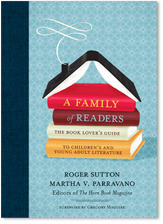 About which book are these reviewers raving, you ask? None other than
FAMILY OF READERS
, edited by Roger Sutton and Martha Pavarrano and published by Candlewick.
About which book are these reviewers raving, you ask? None other than
FAMILY OF READERS
, edited by Roger Sutton and Martha Pavarrano and published by Candlewick.To find out more about this collection of Horn Book essays (including one of mine), curated thoughtfully and wisely by Roger and Martha, join us on Twitter Monday, 11/8, from noon-1 EDT. I'll be asking Roger questions, and you should feel free to chime in. Track the chat with hashtag #familyofreaders, and I'll also be posting the highlights on my blog.
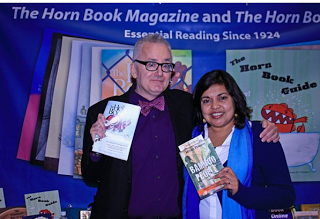
Roger Sutton and me, showing off our products.
Come visit me on the Fire Escape!




Published on November 05, 2010 12:00
October 31, 2010
Amended Guidelines for a Fresh-Eyed Reading of Kid/YA Classics
We're starting our
Cuci Mata
("washing of the eyes" in Indonesian) read of classic children's books this week. Once a month, we'll read a standalone novel written by a beloved author and tap into the power of communal vision. Let's ask ourselves:
When it comes to race, ethnicity, gender, and class, what stands the test of time?
I had previously thought about also asking, "What might the author (if alive) wish to change for today's young readers?" However, I don't want this exercise to become a scathing critique of dead authors, so I've decided that we can learn plenty by keeping our focus on the positive. Let's look for the universal, timeless aspects of a novel that qualify it as a classic. I could do this alone, I suppose, but there's so much more to see when we share a story together. So won't you join me?
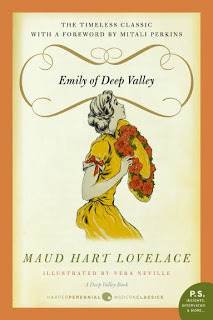 If you've read or are reading
EMILY OF DEEP VALLEY
by Maud Hart Lovelace, tweet your answers to the question above using hashtag #kidclassic or blog a review and leave the link at my blog. I'll compile all tweets and review excerpts in a final post.
If you've read or are reading
EMILY OF DEEP VALLEY
by Maud Hart Lovelace, tweet your answers to the question above using hashtag #kidclassic or blog a review and leave the link at my blog. I'll compile all tweets and review excerpts in a final post.
(Full disclosure: I wrote the foreword to the re-issue of this novel from HarperPerennial as a labor of love.)
Next up:
December 1-7 An Old Fashioned Girl by Louisa May Alcott
January 3-7 The Well-Wishers by Edward EagerCome visit me on the Fire Escape!




When it comes to race, ethnicity, gender, and class, what stands the test of time?
I had previously thought about also asking, "What might the author (if alive) wish to change for today's young readers?" However, I don't want this exercise to become a scathing critique of dead authors, so I've decided that we can learn plenty by keeping our focus on the positive. Let's look for the universal, timeless aspects of a novel that qualify it as a classic. I could do this alone, I suppose, but there's so much more to see when we share a story together. So won't you join me?
 If you've read or are reading
EMILY OF DEEP VALLEY
by Maud Hart Lovelace, tweet your answers to the question above using hashtag #kidclassic or blog a review and leave the link at my blog. I'll compile all tweets and review excerpts in a final post.
If you've read or are reading
EMILY OF DEEP VALLEY
by Maud Hart Lovelace, tweet your answers to the question above using hashtag #kidclassic or blog a review and leave the link at my blog. I'll compile all tweets and review excerpts in a final post. (Full disclosure: I wrote the foreword to the re-issue of this novel from HarperPerennial as a labor of love.)
Next up:
December 1-7 An Old Fashioned Girl by Louisa May Alcott
January 3-7 The Well-Wishers by Edward EagerCome visit me on the Fire Escape!




Published on October 31, 2010 17:20
Guidelines for a Fresh-Eyed Reading of Kid/YA Classics
We're starting our
Cuci Mata
("washing of the eyes" in Indonesian) read of a classic children's books this week. Once a month, we'll read a standalone novel written by a beloved author and tap into the power of communal vision. Let's ask ourselves:
When it comes to race, ethnicity, gender, and class, what stands the test of time?
What might the author wish to change for today's young readers?
I could do this alone, I suppose, but there's so much more to see when we share a story together. So won't you join me?
 If you read or re-read
EMILY OF DEEP VALLEY
by Maud Hart Lovelace from November 1-5, tweet your thoughts about race, class, culture, and gender with hashtag #kidclassic or blog a review and leave the link below. I'll compile all tweets and review excerpts in a final post.
If you read or re-read
EMILY OF DEEP VALLEY
by Maud Hart Lovelace from November 1-5, tweet your thoughts about race, class, culture, and gender with hashtag #kidclassic or blog a review and leave the link below. I'll compile all tweets and review excerpts in a final post.
(Full disclosure: I wrote the foreword to the re-issue of this novel from HarperPerennial as a labor of love, but don't let that stop you from seeing it with fresh eyes and speaking to us about what you see.)
Next up:
December 1-7 An Old Fashioned Girl by Louisa May Alcott
January 3-7 The Well-Wishers by Edward EagerCome visit me on the Fire Escape!




When it comes to race, ethnicity, gender, and class, what stands the test of time?
What might the author wish to change for today's young readers?
I could do this alone, I suppose, but there's so much more to see when we share a story together. So won't you join me?
 If you read or re-read
EMILY OF DEEP VALLEY
by Maud Hart Lovelace from November 1-5, tweet your thoughts about race, class, culture, and gender with hashtag #kidclassic or blog a review and leave the link below. I'll compile all tweets and review excerpts in a final post.
If you read or re-read
EMILY OF DEEP VALLEY
by Maud Hart Lovelace from November 1-5, tweet your thoughts about race, class, culture, and gender with hashtag #kidclassic or blog a review and leave the link below. I'll compile all tweets and review excerpts in a final post. (Full disclosure: I wrote the foreword to the re-issue of this novel from HarperPerennial as a labor of love, but don't let that stop you from seeing it with fresh eyes and speaking to us about what you see.)
Next up:
December 1-7 An Old Fashioned Girl by Louisa May Alcott
January 3-7 The Well-Wishers by Edward EagerCome visit me on the Fire Escape!




Published on October 31, 2010 17:20
October 26, 2010
An Angry Letter From "Burma"
I got a two-page letter in the mail recently, enclosed in a large manila envelope. Here's an excerpt:





Dear Mitali Perkins,
Through reading your novel Bamboo People, we have discovered that you included false accusations and stories of our government. These include purporting that children are "kidnapped," tortured or otherwise harmed by our government. After careful research, we find that these rumors are not true, not right, and a deliberate attack to our government. Your book has been placed under a censored list, and the current copy is banned as of 6/9/10.
As a result of you having tried to attack our government and deliberately cause harm and chaos to our people, the Foreign Affairs office of the government has revised your privileges in this country. Your current visa may be revoked, since if you do come to Burma, it will be for the purpose of distributing your book and tantalizing our people with false ideas. Be warned that the Government of Burma may pursue legal and disciplinary action against you if you try to distribute this book. All laws and policies are strictly enforced, so it is recommended that you immediately stop the publication of this book, destroy it, and not attempt to attack our government again.
Your writing, however, shows some promise, so we suggest you try to continue and focus on other topics that would benefit the Burmese people, such as creative writing of our long and traditional culture.I'll confess that my heart skipped a beat. Thankfully, as I pulled out the rest of the papers in the envelope, I discovered that this was the work of a brilliant 8th grader in Ms. Suzanne Steckert's class at Mt. Pleasant Middle School . Whew. That kid has a bright future in propaganda or fiction. Maybe both. Best wishes, Mr. "Orwell."Come visit me on the Fire Escape!
Thank you,
Akyab Orwell




Published on October 26, 2010 07:35






















